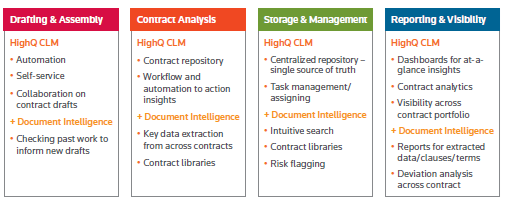When most of an in-house lawyer’s time is spent advising on contracts (with as many as four days out of five typically occupied in this way according to our research), it’s vital that this activity is as efficient and as effective as it can be. For in-house legal teams to achieve the full recognition they deserve as a valued part of the business, they need to be smart about how contracts are managed.
Contracts are far more than simply dry legal documents: they can be sources of risk as well as opportunity, which must be identified so that appropriate and timely action can be taken. Optimising contract management from end-to-end is a way to elevate the service you are providing by improving processes and productivity on the one hand, and delivering deeper insights that lead to improved business outcomes on the other.
Streamlined initiation and execution are clearly a must-have. First and foremost, legal teams need to handle the intake, generation and execution, as well as the renegotiation/renewal of agreements, and be able to collaborate with internal business clients as necessary throughout the ‘lifecycle’ of each contract.
Beyond this, full-spectrum visibility and easy, yet deep, analysis of the entire portfolio are often required too. Understanding exactly what is in all those agreements can play a key role in helping to inform business decision-making.
Streamlining the pre-signature process
Essentially, there are two interlinked aspects to legal contract management: the pre-signature and the post-signature elements.
Many corporate legal teams use the contract lifecycle management (CLM) capabilities in HighQ, the legal business management software that simplifies legal processes and enables collaboration with business clients, to handle the pre-signature and CLM process seamlessly.
HighQ Contract Lifecycle Management provides a central collaboration space, in which documents can be created and executed, workflows managed, reporting can take place and data is easily visualised. It acts as a secure, central contract repository: a single source of truth.
Intake tools help manage incoming requests, and actions are allocated to the relevant people with helpful links, prompts and alerts. The creation of key documents can be automated to embed quality and consistency, save time, and provide users with fast, accurate outputs that free up their time for other tasks, while eSignature makes approval easy. Plus, it contains AI-enabled document review so documents can be appropriately classified and data, including clauses, extracted. Towards the end of the contract term, it can flag renewal dates, and the user can attach workflow rules such as assigned reminders to action. Thus, the lifecycle of each contract is managed effortlessly.
Shining a powerful spotlight post-signature
However, with hundreds – often thousands – of agreements in many companies’ systems, gaining relevant, usable insights into those documents after they’ve been signed can be incredibly complex and challenging. This is where contract analytics platform Document Intelligence comes into its own because it uses pre-trained AI to read, organise and manage contracts to deliver the transparency and insights you need.
It can automatically identify, understand and organise key data contained within large volumes of documents, extracting what’s relevant and delivering insights to pinpoint errors or deviations in a matter of minutes to mitigate risk. What’s more, it can quickly surface key terms and dates across an entire database to simplify obligation management, and then export reports to assist with analysis.
The many use-cases that Document Intelligence can unlock range from identifying and managing contractual obligations (e.g. surfacing missing provisions or flagging fees) to enhancing the M&A due diligence process (e.g. when reviewing an acquisition target’s contracts), or getting a quick understanding of how contracts might be affected by a strategic business decision such as an expansion into a new territory or a divestment). Moreover, it can surface and leverage past examples of contracts and clauses to help inform drafting, analyse terms you have agreed to in the past and compare third-party contracts against your playbook.
Such functionality is empowering for lawyers – and for the organisation as a whole. Kirsten Maslen, Director, Product Marketing, LegalTech at Thomson Reuters explains,
“Being a strategic partner to the business means being on top of the data that is held in contractual assets so that you quickly assess the impact of what’s coming up, what the business’s exposure is and what pre-emptive action to take so the business is on the front foot.”
Getting the best of both worlds
Where in-house legal teams want both capabilities in order to manage, visualise and collaborate on contracts in one end-to-end contracting solution that goes beyond traditional CLM, HighQ can integrate seamlessly with Document Intelligence (as well as other third-party AI document analysis tools).
In combination, the two create a powerful solution that helps you capture risks and respond rapidly to business needs. For example, you can send documents directly from your HighQ contract repository into Document Intelligence to extract key provisions into a manageable iSheet. From there, you can then work on the extracted data back in HighQ.
So, you can easily see, for instance, which contracts are missing certain provisions, and which are coming up for renewal without having to read through each one individually – saving time and headaches. Provisions requiring further review are auto-flagged, tasks and workflows around those provisions are automated (for instance amendments can be auto-formulated instead of lawyers drafting hundreds individually), and contract content reports generated. In this way, results can be actioned and monitored painlessly.
In summary, together, the two solutions deliver:

1. Delivering timely answers to business-critical questions
Importantly, this integration means that lawyers can use HighQ and Document Intelligence together in a dynamic way to answer business-critical questions quickly such as:
- Do our contracts contain any limitations that would impact our ability to take a specific action?
- What powers do our contracts contain that we could leverage to grow a particular part of our business?
- What commercial positions have we agreed to in the past? Does the suggested approach on this particular project align with our past dealings?
- Which contracts are affected by a particular situation (such as a commercial imperative or a change in policy or regulation)?
These kinds of queries can be hard to answer in the absence of an AI-powered solution, as they may relate to multiple contracts that would otherwise need to be manually analysed. Kirsten Maslen says, “If lawyers don’t know the answers to questions like ‘can we outsource’, ‘how exposed are we to a particular regulatory change’ or ‘can we extract ourselves from this relationship’, it creates delay, which could cause the business to suffer reputational damage or financial consequences, for instance from missed opportunities, litigation risk or regulatory sanctions.”
“By deploying Document Intelligence to generate the necessary data and HighQ CLM to process it and automate outputs, you’re reducing that lag and supporting the business in a timely manner through whatever commercial imperatives, economic shocks or regulatory changes it is facing.”
2. Stepping up performance and productivity
The net result of all this is that legal teams can elevate their own performance and standing within the business, while simultaneously being able to drive efficiency gains within their own department. Lawyers estimate that they can save around a third of the time needed for reviewing document sets with Document Intelligence, and 85% believe its use would make them more productive.
________________________________________________________________________
To find out more about how HighQ CLM and Document Intelligence – alone or in tandem – can help your teamwork smarter and deliver more value to your business, contact us today.



